What you need to know to create an outstanding perennial border
I’ve asked top gardeners Steve Edney and Louise Dowle for their tips on how to create an outstanding perennial border.
They’ve just created one of the longest herbaceous borders in the UK – from scratch. It was a field two years ago. Now it’s a stunning, harmonious display of beautiful perennials and annuals.
And they’ve experimented with grouping plants together, in a way that works just as well for smaller gardens. It’s also where they grow plants for their No Name Nursery, growing them in natural conditions and seeing how they work in borders.

Lou Dowle and Steve Edney at their No Name Nursery in Kent. You can follow Steve and the progress of the long border on Instagram here.
At 100 metres long, Louise and Steve’s border may well be the longest private border. Other ‘longest’ borders are at Kew Botanic Gardens (320 metres) and RHS Wisley (128 metres).
It’s part of their No Name Nursery project that is part plant nursery and possible future workshop space. But it’s also a ‘place to escape’ and share with the wildlife in the garden and the wider countryside beyond. The planting is wildlife-friendly, there are lots of wilder spots for shelter and they have a ‘no sprays’ policy.
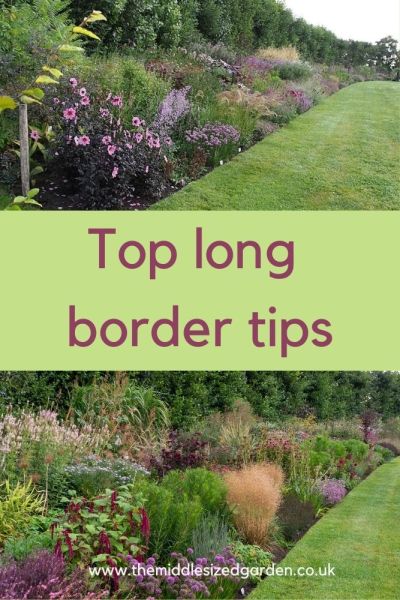
Steve and Lou’s border is 100 metres long, planted with over 500 plants. This gives them a chance to experiment with different combinations of plants and to see how plants work together.
‘We want to be able to experiment with plants by growing them together,’ says Steve. ‘Many nurseries are primarily about growing plants – and they grow them brilliantly. But they’re not usually growing them in a garden context. Whereas both Louise and I are gardeners as well as plant growers.’
The No Name Nursery also aims to focus on growing plants in the ground, rather than in pots. They’ll be selling plants from next year, often at plant fairs and they may also have some open days. The website is yet to come, but you can contact Louise and Steve by email.
Organic flower gardening
Steve and Louise also garden organically. Steve says that gardening today is about ‘balance’ not about eradicating pests. ‘You need a good balance of pests and predators in your garden,’ he says. In this post on keeping dahlias free of earwigs, slugs and snails without using chemicals, he explains why.
For example, earwigs do a lot of damage to dahlia flowers but they also eat aphids. So if you get rid of earwigs, you’ll have more aphids. He suggests growing dahlias that appeal to earwigs less, such as the single flowered dahlias. And if you do grow the big decorative dahlias, smear some Vaseline on the main stems to discourage the earwigs.
There’s more about effective ways to control slugs and snails here.
Start with your soil and site
When you’re choosing plants for a perennial border, you have to start with the soil and site, says Steve. ‘I know you hear that a lot, so it can sound a bit boring, but it’s essential.’
Things to consider include what kind of soil you have. Not just whether it’s sandy, silty or clay, but does it have standing water in the winter, for example? ‘Or does it get very dry in the summer?’
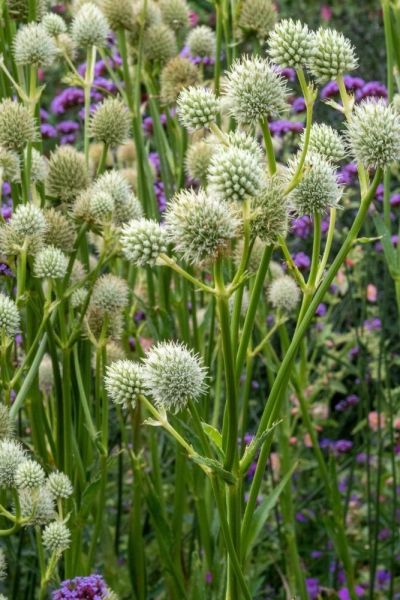
Think about your soil and climate. Steve and Lou chose this Eryngium yuccifolium because it’s drought resistant. It also has beautiful seed heads so has a long season of interest in the garden.
As well as understanding your soil, think about your local climate. For example, Steve and Lou’s garden is in East Kent, where we have some of the highest sunshine in the UK, but also the least rainfall.
In the US, gardeners are very aware of which USDA hardiness zone they’re in. But UK gardeners are less concerned because most of the UK has quite mild (and relatively similar) winters. However, other aspects of the weather vary in different areas, so we have places which are wetter, drier, more windy or more sheltered. Those factors are just as important.
Think about the proportions as well as the size of the border
‘Make sure that your perennial border isn’t too apologetic,’ says Steve. ‘Sometimes people are afraid to make a border that’s larger than they think they can cope with. But if you plant it densely enough, it will keep the weeds at bay.
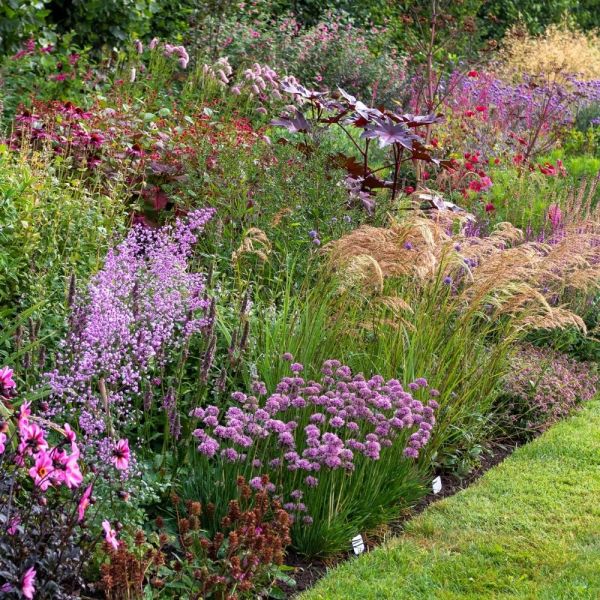
Think about proportions when planning a border. How high is your fence or wall? How long is the border? If it is long, don’t make it too narrow or the proportions will be wrong.
‘You don’t want a border that is too skinny and too long. And you don’t want it to be dumpy.’ So it shouldn’t be too deep but narrow. So it has a lot to do with your site or garden. ‘It doesn’t matter if it’s 100 metres long or two metres long, you should listen to your instinct’, says Steve. ‘Does it feel right? Does it look right?’ If not, it may be the proportion.
Think also about your boundaries and how they affect the proportions of the border.
Steve and Louise have a very tall line of trees on their boundary. ‘It’s a great windbreak,’ says Steve. ‘But it’s so tall. You need a deep border to balance the tallness of those trees. But if you had a small garden with a low fence or hedge, you wouldn’t necessarily want to fill the whole garden with the border.’
When do you want your perennial border to be at its peak?
Although we all aspire to having a year round border, the reality is that most of us have borders which reach their peaks in one or two seasons. Steve suggests that you actively plan that peak for when you’re going to enjoy the garden most.
Think about when you sit in your garden most frequently. And equally, note when you’re most likely to be away.
For example, Steve says he loves Daphne bholua. It has beautifully fragrant flowers in February, ‘but in summer, it’s dead boring. So if you rarely go in your garden in winter, don’t plant it at the bottom of the garden where you will never see it.’
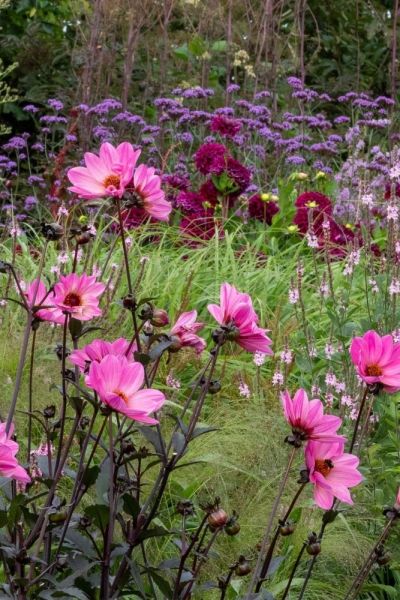
Steve and Lou planned their long border to be at its best in high and late summer. This is Dahlia ‘Lovely Eyes Loulou’, currently going through the dahlia trials at RHS Wisley. You can see verbena bonariensis in the background.
(When I’m planning a border in the Middlesized Garden, I find it helpful to use my Beautiful Borders Planning Checklist, which is free to download here. This is where you can list plant names with their characteristics, so that you can easily cross-check them.
Position key plants first
Steve and Louise started by positioning roses, shrubs and long-lasting evergreen perennials first. ‘Then the rest of the border was stitched round them.’
You can ‘impulse buy’ but only if…
Make a list of plants before you go shopping for a perennial border. That’s good advice from professional gardeners and garden designer – find it here in how to plan a truly successful flower border.
‘But it’s exciting to impulse buy,’ says Steve. When he visits plant fairs or nurseries, he loves to buy plants he doesn’t know.
However, before you actually buy an impulse buy plant, he says, ‘make sure it’s going to suit your garden’. Have you got the right soil for the plant? Is it going to be able to cope if you’ve got a windy site? Or if your site is very sheltered, have you got too much shade? Find out all that key information about what the plant needs before you buy.
And find out from the plant grower when the plant is going to be at its flowering peak, so that it fits in with your wants and needs. If you’ve designed your border to be at its peak in high and late summer, then get ‘impulse buys’ that fit in.
If you’d like to know more about how to choose the right perennial plants for your garden, check out this post on perennials made simple, with advice from Rosy Hardy of Hardy’s Cottage Garden Plants.
How to partner plants in a perennial border
Think about when your plant will be flowering at its peak. And then consider what the plants around it will be offering at that point. You don’t need them all flowering together, says Steve, but think about the foliage or textural contrast.
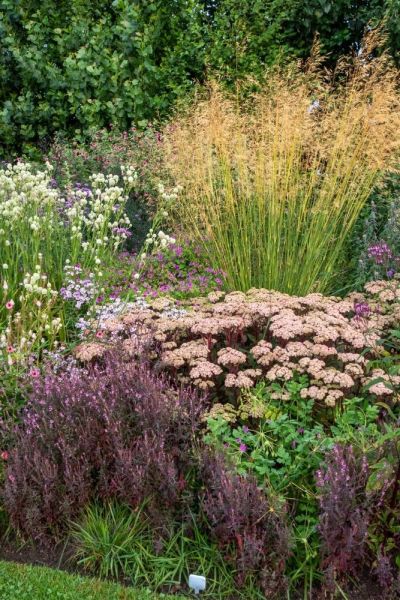
When creating a perennial border, partner plants that have something to offer at a similar time of year. That may be foliage or flower colour, structure or seedheads. For tips on how Steve and Lou put this grouping together, see this video on YouTube.
When choosing plants, think about what it has offer throughout the year. ‘Take Eryngium yuccifolium, for example,’ he says. ‘It’s called yuccifolium because it has yucca-like leaves. So it has a really good rosette of foliage earlier in the year, which partners the earlier plants well.
Then when the border is at its peak, it has flowers and a beautiful seed-head.’ It’s drought-tolerant, so good for the climate. And ‘for a tall plant, it’s surprisingly stable. The flowers are tall, but the main body of the plant is lower.’
For example, dahlias can be quite difficult to partner in a border because they’re so showy, says Steve. So if you’re thinking about the overall border effect, choose the right dahlia.
He loves the single flowered, black leafed ones in a border context, such as Dovegrove and Lovely Eyes Loulou. Sedums (now called hylotelephiums) are a good plant to partner with dahlias, he says. ‘Red Corley’ is a really good short sedum to partner with a black leafed dahlia.
You can hear more of Steve’s dahlia advice in this post on how to grow dahlias.
Why the classic height graded perennial border works best
Many plants don’t look good at the base, or don’t have much to offer at the base. The obvious one is roses, which are often described as ‘a beautiful flower but an ugly plant’. But Steve also thinks that dahlias and many others look best with lower plants in front of them or around them.
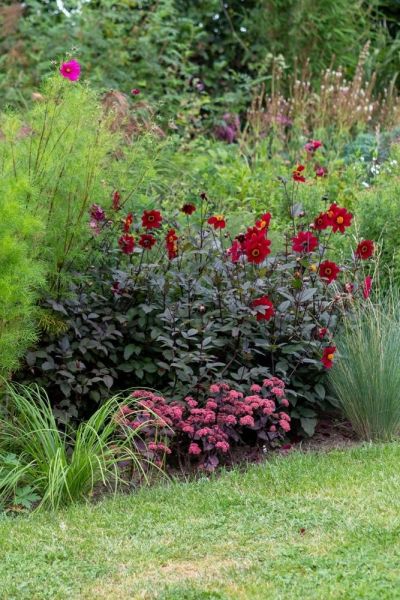
Steve thinks the classic system of grading plant heights in a herbaceous border works well. He likes to cover up the base of many plants, such as dahlias and roses, with low growing flowers. Here dahlia Dovegrove is partnered with a low growing Hylotelephium ‘Xenon’
‘I don’t like to see stems or bare earth. And I like to work in gradations. It’s very classic to start with the smallest at the front, working your way to the tallest at the back. If you work on that principle, then you’ll also know when to break that rule.
The rule of thirds in a perennial border
The rule of thirds is a famous design rule. And it works in a perennial border as well.
Steve suggests you move the layers up in thirds (or 50% at the most). ‘When you’re starting out, a good rule of thumb is place plants next to ones that are around one third taller or shorter.’ The exception is with grasses because they’re so light, and their movement is important.
He also suggests that you don’t plant more than one third of the perennial border as grasses. ‘If you have too high a proportion of grasses, there’ll be a point in the year when you feel there isn’t enough flower interest.’
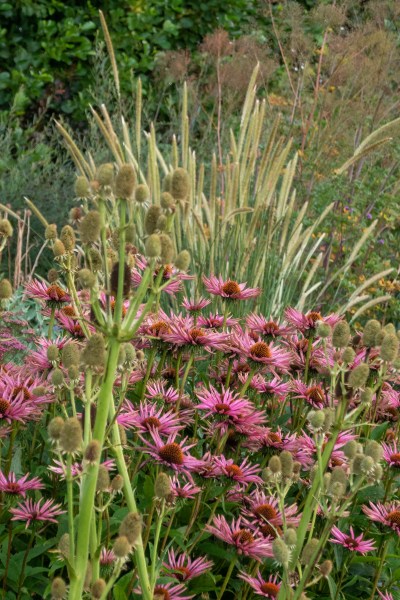
Rule of thirds: plants often look best when they’re around one third higher or lower than the plant next to them. This unknown echinacea seedling looks brilliant with the taller pennisetum behind it.
Note that prairie planting, where the plants are all mainly at a similar level and which uses airy plants like grasses so you can see through layers, is a different style of border. But it’s a harder one to get right, although it looks very natural. A classic herbaceous border is very much about English country style, and it’s established itself as a major element in gardening around the world.
Think about contrast
Contrast tall plants with shorter ones. And the rule of thirds about height doesn’t necessarily apply to ornamental grasses because they are so transparent and add movement. ‘Don’t be afraid to plant grasses which are significantly larger than some of your other plants in the border.’
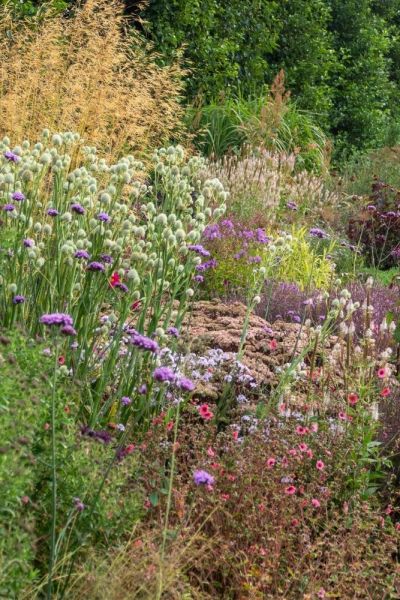
Here Stipa ‘Kleinfontain’ towers over the Eryngium and, shorter again, the Hylotelephium Matrona, and then the Verbena ‘Bampton’. But the taller grasses and the eryngium are both quite transparent, so they are a light presence.
There are more tips on placing ornamental grasses in a border in this post on naturalistic planting with advice from garden designer Michael McCoy.
And foliage contrast is hugely important too. Place narrow leaves next to broad-leafed ones. ‘Different leaf shapes are particularly important in the spring and early summer when plants are developing and growing. So you can achieve real drama with the plants even when they’re out of flower.’
You can contrast mounded plant shapes with sculptural ones. Behind a clump of rounded Hylotelephium (formerly sedum) Matrona is a fountain of grass, Stipa gigantea ‘Kleinfontaine.’
‘For example, I particularly love the contrast of the elegant, sculptural eryngium with the quite gaudy hot pink of Potentilla Miss Wilmott,’ says Steve.
The edges of a perennial border make the difference
Steve pays particularly attention to the edges of the borders. Firstly, he likes the plants at the edge to be long-flowering, such as the pretty Potentilla ‘Miss Wilmott’.
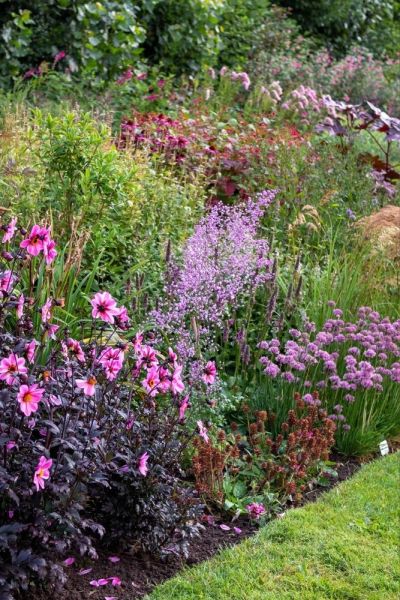
Contrast the effervescence of a fully flowering perennial border with a clean, sharp edge. Dahlia ‘Wishes & Dreams’ and Allium senescens ‘Lisa Blue’ are at the edge.
‘And verbena officinalis Bampton has incredible purple foliage, purple flowers and a really long flowering period. So we’ve placed it at the edge of the border.
Steve describes his border as ‘quite chaotic’. By this he means packed with plants. So he likes to cut a sharp edge between the border and the lawn to define it. He says that it’s important to contrast with the ‘chaos.’
Edit your perennial border regularly
If something’s got a bit too big, then trim it back mid-season. And some plants self seed too prolifically, so weed them out.
‘The thing you always have to watch for is that one plant doesn’t get too big for its boots and start crowding another plant out,’ he says.
We like to think of our borders as like a slow-burning firework display.
Think about the height of a plant, its foliage, its other three seasons of interest when not flowering, their flowering seasons, their attraction to wildlife, what their seedheads are going to be like, their length of flowering period
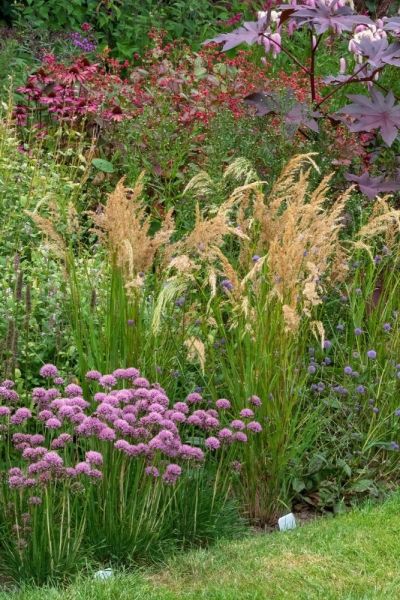
Clockwise from top left: Persicaria ‘Indian Summer’, Ricinus ‘New Zealand purple’, ornamental grass, Allium ‘Lisa Blue’. Steve and Lou don’t agree that the Persicaria should be in this clump. You can learn a lot about the positioning of perennial plants by listening to the discussion about this between them on this YouTube video.
Expert tips on top perennial border plants
One aspect that is worth considering is your budget. It can be surprisingly expensive to fill an entire border in just a year or so, but I’ve researched eight ways of making a border on a budget in this post.
Steve is a leading authority on dahlias. Read his top tips on choosing and growing dahlias here. And salvias are another long-flowering colourful border plant. The UK’s leading authority on salvias is William Dyson, who tells us what we need to know about salvias here. There are five other good perennial plant suggestions here.
Irises are dramatically beautiful flowers and surprisingly tough, too. One of the leading iris nurseries is Irises of Sissinghurst – read how to grow irises here.
And what would a garden be without roses? Here are rose growing tips from Neil Miller who runs the award-winning rose garden at Hever Castle.
An increasing number of gardeners are planting their main borders in autumn rather than spring, because spring is getting very dry. However, not all plants can be planted in autumn. See this post on whether it’s better to plant in spring or autumn.
Another big consideration is how resilient your plants are. In the UK (and around the world), last summer was exceptionally hot and dry, but we had some very cold or wet spells in winter, too. There have been more plant losses this year than I ever remember. So it’s worth thinking about resilient plants, which will put up with both drought and rain.
And if you are starting a border from scratch or completely revamping a border, then Revamp a border – 11 tips on how to turn scrappy into sensational covers the essential preparatory stages.
Pin to remember how to create a perennial border
Steve goes into detail about how they made their plant choices for one particular section in this video How to create an outstanding perennial border.
And there is a wonderful discussion/argument between Steve and Louise over whether one plant – Persicaria ‘Indian Summer’ – fits in the border or not. I really felt I learned about eavesdropping this particular thought process. You can find it at 14 minutes in. And you can click straight through to it, if you look in the description below the video where there are highlighted time stamps.
And do sign up here for a free weekly email with tips, ideas and inspiration for your garden.

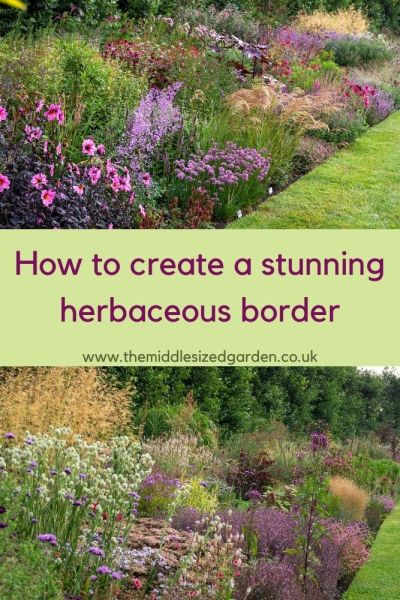























Hi Steve, I am Lesley that was asking about a large plant in my garden. I think it is a new Zealand flax.
Steve doesn’t log into this site, do you want to repeat your query and I’ll see if I can answer it? Or you may want to contact Steve on whichever platform you originally spoke on (Instagram?)
I watched this video with fascination – it was one of the best discussions I have seen on this subject. I continue to struggle again impulse buy and only buying one of a particular plant when perhaps I should buy 3 5 or more.
I was interested in Steves point about the dense spacing of the bed and wondered if you could cover the subject in more detail.
How to have the courage to put things closer togeher then the label – and when to have just one ‘instance’ of a plant and when to have more than one.
eg. at its simplest you would perhaps have one Rose or one Hydranga in a bed wheras multiple Rudbekia’s or multiple geraniums ? How to guard yourself towards making the right choices when buying at the garden centre. I am always leary of mail order because things often then arrive when I’ve got no time to plant or when the weather is so bad. Then when I have time or the weather improves I confess I may have forgotton about the plants (or even worse plants plural!) and they are pot bound or short of water befoer they ever get in the soil.
[Steves comment was something like – leave no bare soil – no room for weeds]
I’ll ask him when I see him next, which should be soon.